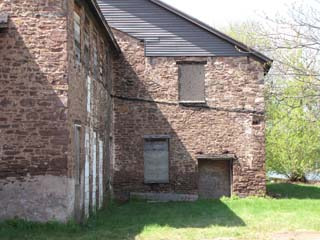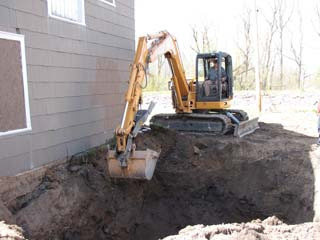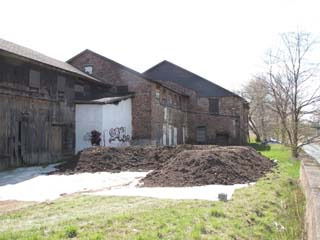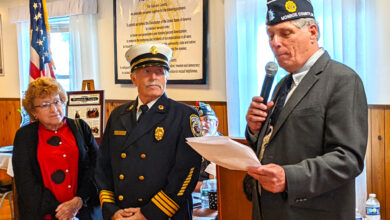Following remediation, canalside site ready for new use
by Kristina Gabalski
 Constructed of Medina sandstone and originally the site of Hiel Brockway’s boat and brick yard, the Whiteside Barnett and Company buildings date to 1850, and are rare surviving examples of industrial buildings along the Erie Canal. The historic former Whiteside Barnett and Company warehouse at 60 Clinton Street in the Village of Brockport is ready for a developer.
Constructed of Medina sandstone and originally the site of Hiel Brockway’s boat and brick yard, the Whiteside Barnett and Company buildings date to 1850, and are rare surviving examples of industrial buildings along the Erie Canal. The historic former Whiteside Barnett and Company warehouse at 60 Clinton Street in the Village of Brockport is ready for a developer.
The Greater Brockport Development Corporation (GBDC), which owns the complex of three inter-connected buildings – two of them constructed of Medina sandstone – removed 200 tons of contaminated soil from the site in mid-April.
“We’re thrilled the community has it back as a viable development-ready property,” GBDC president Gary Skoog says.
GBDC acquired the property several years ago with the help of a HUD grant and a goal of working to preserve and redevelop the rare Erie Canal era buildings. Skoog says HUD grant funds also helped with the cost of the clean-up of the site.
The clean-up is now complete, Skoog says, with the excavation and removal of soil which was contaminated with petroleum distillates from the years the buildings were used as an automotive repair shop.
“We’re thrilled that this is over,” Skoog says of the clean-up. He explains that officials from the New York State DEC and engineers from LaBella Associates were at the site while the contaminated soil was being removed.
 Digging for soil samples.“Every single scoop of soil was monitored for level of contamination,” he explains.
Digging for soil samples.“Every single scoop of soil was monitored for level of contamination,” he explains.
The contaminated soil was trucked to the Mill Seat Landfill in Riga for disposal, Skoog says, and the site was leveled-off with clean fill. “Fortunately, the village had some stockpiled fill for just such a use. It didn’t cost the village a dime,” he notes.
Local businesses and contractors were used for the excavation and removal of contaminated soil, Skoog says.
The way is cleared for re-development of the buildings, which stand on the south bank of the Erie Canal just west of the historic downtown business district.
“We’re talking with developers,” Skoog says. “Three people are interested in the property right now.”
GBDC vice-president Bill Andrews says the Whiteside Barnett site serves as “the anchor” for the re-development of the Clinton Street area. “It’s the largest area in the village that is underused,” he says and notes that the location on the canal adjacent to the business district and near The College at Brockport campus and residential areas, is ideal.
Both Andrews and Skoog say they want the community to “look at Clinton Street in a different way. We hope that people will look at Clinton Street more kindly.”
The complex is part of the Clinton Street District Revitalization Plan which recommends small-scale mixed use of buildings in the area. Re-development of the Whiteside Barnett complex must incorporate the Erie Canal and the historic character of the neighborhood, Andrews and Skoog say.
 The interior of the Whiteside Barnett and Company warehouse offers about 10,000 square feet total of space in a business use zoning district. Contaminated soil on the site has been removed and clean fill leveled around the building. The buildings are also listed on the state and national historic registers.The three buildings include 10,000 sq. ft. of space and sit on approximately one-third of an acre. The lot has approximately 185 ft. of canal frontage and about the same on the street and is in a business use zoning district, Skoog says. He and Andrews say GBDC would like to see a mix of retail shops/cafes at the site.
The interior of the Whiteside Barnett and Company warehouse offers about 10,000 square feet total of space in a business use zoning district. Contaminated soil on the site has been removed and clean fill leveled around the building. The buildings are also listed on the state and national historic registers.The three buildings include 10,000 sq. ft. of space and sit on approximately one-third of an acre. The lot has approximately 185 ft. of canal frontage and about the same on the street and is in a business use zoning district, Skoog says. He and Andrews say GBDC would like to see a mix of retail shops/cafes at the site.
Originally the site of Hiel Brockway’s boat and brick yard, the Whiteside Barnett and Company buildings date to 1850, Andrews says, and are rare surviving examples of industrial buildings along the Erie Canal. The buildings are also listed on the state and national historic registers.
The Whiteside Barnett buildings were used for a variety of businesses over the years. First as a farm implement factory and later as a flour mill, lumber yard, canning factory and finally as an auto repair shop, Andrews says.
Gary Skoog notes that there is “an energy in the village” now and that the Whiteside Barnett buildings offer a wonderful opportunity for development along the canal.
“We’re all in this together,” he says. “The community depends on all of us doing something to make this a better place to live.”





